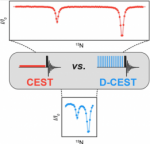
Chemical exchange saturation transfer (CEST) has recently evolved into a powerful approach for studying sparsely populated, “invisible” protein states in slow exchange with a major, visible conformer. Central to the technique is the use of a weak, highly selective radio‐frequency field that is applied at different frequency offsets in successive experiments, “searching” for minor state resonances. The recording of CEST profiles with enough points to ensure coverage of the entire spectrum at sufficient resolution can be time‐consuming, especially for applications that require high static magnetic fields or when small chemical shift differences between exchanging states must be quantified. Here, we show – with applications involving 15N CEST – that the process can be significantly accelerated by using a multi‐frequency irradiation scheme, leading in some applications to an order of magnitude savings in measurement time.

Pour plus d’informations, n’hésitez pas à consulter le communiqué de presse : Observer la dynamique des biomolécules en un temps record !
References:
Dramatic Decrease in CEST Measurement Times Using Multi-Site Excitation
Tairan Yuwen, Lewis E. Kay, and Guillaume Bouvignies
ChemPhysChem 2018, 19, 1707-1710
DOI: 10.1002/cphc.201800249
Dramatic Decrease in CEST Measurement Times Using Multi-Site Excitation
